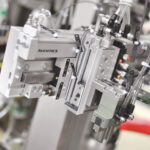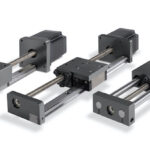Round rail linear guides can offer the lowest overall cost of ownership, but machine designers often specify profile-rail for its compactness as well as its higher rigidity, load capacity, and accuracy. Here’s how to extend the life of these linear-motion components.
By Curtis McCreight • product line specialist | Thomson Industries
Dave Buckley • industrial automation manager | Motion
Design engineers integrate profile-rail (also called square rail) linear guides in various applications — ranging from miniature rails to guide pipettes on laboratory blood analyzers to heavy-duty profile rail on large multi-axis robot systems transferring pallets in factories. Profile rails’ high rigidity also makes them suitable for CNC-machine applications and semiconductor production.

As with all linear motion components, durability is primarily a function of application-dictated speed, load, and duty cycle. Within those parameters, diligent lubrication and contamination protection are key to extending the life of profile-rail linear guides. After all, linear bearings are open — in sharp contrast with radial bearings having seals to contain lubrication and shield against contamination.
Other factors affecting profile-rail durability include sizing, the internal component architecture, and mounting … with all choices having their own tradeoffs.
Linear profile-rail lubrication best practices
About 75% of all profile rail failures result from inadequate lubrication or contamination. Like an automobile oil change, rail and bearing lubrication must happen regularly to help prevent corrosion caused by solid and liquid contamination. Lubrication flushes out destructive particulates and minimizes friction and wear. Annual relubrication may be sufficient in a clean environment such as a medical imaging room, but monthly lubrication intervals may be required if the profile rail operates in a dirty factory.
Most machine end users prefer to align lubrication frequency with routine preventive-maintenance schedules. If inspection indicates that the purged grease is degraded or that the rail is very dry, the application may need more frequent relubrication. Conversely, operators can extend lubrication intervals if (upon servicing) the purged grease is in good shape and the rail looks adequately lubricated.
One option is self-lubricating reservoirs on the blocks (carriages) with additional seals and scrapers available. Some profile-rail manufacturers offer blocks with spacers between the balls. These spacers dramatically lower the friction between balls and trap lubrication but can also trap certain contaminants. So spacers serve to extend life where contamination is minor, but can shorten life by restricting the lubricant’s ability to purge contaminants if the operational environment is subject to a lot of debris.
It’s also important to choose and properly apply greases that are especially suited for all applicable machine design challenges — for example, food-safe greases and high-temperature greases. Personnel servicing the rail should continue adding lubrication into the blocks’ lubrication ports until fresh grease emerges from the block and then cycle a few times to spread lubrication over the rails.
Machines should never run without lubrication.
Maintenance technicians should also clean seals and wipers often for maximum protection from the environment, and regularly replace worn seals and wipers.
When replacing carriages reaching their end of life, end users should seriously consider new rails because they also wear and can become damaged over time. Mounting a brand-new carriage on an already-worn rail may cause the new carriage to prematurely wear or possibly even catastrophically fail without warning.
In summary: It bears repeating that most profile-rail failures result from poor lubrication practices or contamination issues, making proper protection and maintenance a priority over all other considerations.
Right-sizing linear profile-rail
While the motion profile will dictate overall sizing parameters, there may be room for some variations to improve system life. Nominal profile rail widths range from 5 to 100 mm and are available in lengths of up to six meters as a single piece. For pieces exceeding typical stock lengths of three to four meters, the rails can be butt joined. However, such joining requires special end machining on the butting ends to minimize any gap between the connected rails. Installation alignment is also more critical when sections of rail are joined together as no gap between the rails can exceed one-half the carriage ball diameter (if smooth operation and long component life are to be achieved).

The larger the linear rail, the greater the load capacity — and using a smaller percentage of a rail’s maximum capacity can extend its life. For example, a 500-lb-capacity rail constantly moving 100 lb will last much longer than the same system continuously tasked with transporting 500 lb.
Some machine builders (in an effort to extend the life of the entire assembly) oversize the profile-rail linear bearings. Others oversize profile rail for aesthetic purposes — with the thought being that perhaps a half-inch profile rail driving a one-inch ballscrew looks out of balance. Still other machine builders specify linear rail that’s larger than that required by the motion profile for both durability and improved visual balance to justify the added cost.
Linear-rail carriage sizing can also affect durability. Longer blocks have more load capacity than smaller blocks, and wider blocks allow for more mounting options.
In fact, if the installation features the correct level of protection against contamination and receives lubrication at intervals recommended by the component supplier, the profile-rail linear bearing’s life will typically far exceed calculated L10 life predictions. Online sizing and selection tools make it easy for designers to get a precise configuration. Such tools also provide technical information, 3D CAD drawings, pricing, and lead times.

Linear profile-rail preload issues
Manufacturers can add preload to carriages by oversizing the rolling elements. But machine designers wanting to specify heightened profile-rail preloading to increase rigidity and decrease deflection should first verify whether such preloading is necessary. For most applications, standard manufacturer preloads are usually perfect. What’s more, if a profile-rail linear bearing installs on a horizontal axis, preloading may be redundant. That’s because the weight of the payload usually imparts far more rigidity (and decreased deflection) than any preloading could.
Preloading will shorten life. That said, given that preload is only up to 13% of the rated dynamic load capacity, the benefits of preloading where applicable typically outweigh the impact on life. Applications requiring increased preloads include linear bearings used on CNC machining centers. If the design calls for a single rail but the load isn’t on the center line of the rail and carriage, increasing the size of the block and rail and/or adding preload may be necessary to handle the moment loading. This can be avoided using a two-block and rail assembly with the load between the rails. Twin rails remove the loading moment, reduce the required rail and carriage size, and eliminate the need for preloading.
Alignment and surface preparation of linear profile-rail
All else being equal, an assembly with well-aligned subcomponents will outlast one with poorly aligned elements. Alignment is primarily a function of surface preparation. It’s critical to bolt profile rail to a precisely machined surface. Without a properly prepared mounting surface, the guide will run rough and require replacement more often. Even minor flatness errors in the mounting surface can reduce bearing life by up to 50%, and more severe alignment issues can lead to immediate failure. Large applications such as CNC machines and robotics demand the highest possible rigidity; all items must be secured as tightly as possible to avoid drift during operation.
If proper surface preparation has been achieved, the next issue is creating parallelism between rails. This becomes especially important if the blocks are preloaded, resulting in much less play. Misalignment significantly increases loading and a subsequent drop in bearing life. In larger precision applications, parallelism may require laser measuring to achieve the required level.
Surface preparation can be expensive, however. If a design can tolerate less accuracy and more compliance, money can be saved because less surface preparation is needed. Ultimately, the required amount of surface preparation for a profile rail depends on the arrangement of the rolling elements and the required precision level.
In summary: Proper alignment significantly impacts rail durability. Good alignment depends on sufficient investment in mounting surface quality that designers can adjust based on their requirements for accuracy and compliance.
Arrangement of rolling elements
Machine designers can specify profile rail having rolling elements arranged in a few different ways to satisfy target tolerances, compliance, and budgetary constraints, and these in turn affect the amount of installation surface preparation required. The following profile-rail internal architectures are most common.
- A double-backed architecture arranges four ball or roller tracks (each with two contact points) to maximize rigidity and moment arm D.
- A Gothic-arch architecture arranges two larger ball tracks (each with four contact points) to allow smaller rail sizes while minimizing degradation of rigidity and allowing for an intermediate moment arm D.
- A double-faced architecture arranges four ball tracks (each with two contact points) higher on the rail to increase compliance while minimizing degradation of the moment arm D.
The most rigid and accurate rolling element choice is the double-backed configuration, which requires the most significant investment in surface preparation. The Gothic arch configuration is the next-most rigid and accurate, needing less surface preparation. The double-faced design is the least rigid and most compliant, thus requiring the least investment in surface preparation. But even machine designers not needing maximum accuracy or rigidity can still optimize for longer life by specifying as much surface preparation as the budget will allow.

Manufacturers employ various configuration combinations of their profile bearings. Some use a back-to-back or face-to-face configuration with further variations of raceway shapes. Plus, some include a Gothic arch, round arch, oval arch, or V-groove shape. Extensive test reports abound on the advantages of every manufacturer’s chosen method. In practice, every manufacturer’s product meets or exceeds their published L10 life directly dependent on proper sizing, lubrication, and corrosion protection.
Linear profile rail and carriage count
A typical profile rail system involves two rails with two carriages on each rail. Adding rails or carriages to the system usually adds design risk because the application becomes exponentially more complex. However, some project requirements outweigh these challenges. Large application envelopes or prioritizing the absolute minimum deflection are examples where the tradeoffs make a higher rail and carriage count worth the increased alignment requirements.
In summary: Choosing oversized rails, avoiding unnecessary preloading, and deploying multiple rails or carriages can also extend profile-rail life. That said, implementing more than two of these introduces complexities that can shorten life if not handled skillfully.
Motion | motion.com/home/designworld
Curtis McCreight is product line specialist for linear bearings and guides at Thomson Industries. He is also the technical and commercial subject matter expert for the Thomson linear guide product line in North America. He earned his A.S. in Engineering from Brightpoint Community College and is studying for a B.S. in Supply Chain and Operations Management from Western Governors University. McCreight has worked at Thomson for nine years. He started in customer service and then became a technical quoting specialist before assuming his current role.
Dave Buckley is an industrial automation manager at Motion focusing on automation and linear motion. He has 58 years of experience in industrial design and specialized in fluid power before moving on to automation design in 1985. Initially spending 17 years in design engineering in the steel industry at Dofasco and then Stelco (later U.S. Steel), Buckley moved to technical sales and became the Canadian Director of Marketing and Sales for Bosch Rexroth (then called Basic Technologies). He later served as Canadian Manager for THK America before landing at Motion.







Leave a Reply
You must be logged in to post a comment.